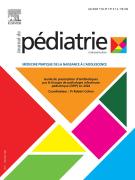Aspects épidémiologiques, thérapeutiques et pronostiques de l’anémie du prématuré au centre hospitalier d’Essos, Yaoundé, Cameroun - 05/12/20
Epidemiological, therapeutic and prognostic of anemia amongst premature newborn babies in Centre Hospitalier d’Essos, Yaounde, Cameroon

| pages | 7 |
| Iconographies | 2 |
| Vidéos | 0 |
| Autres | 0 |
Résumé |
Introduction |
Peu d’études ont rapporté les caractéristiques de l’anémie du prématuré dans les pays à ressources limitées. Notre objectif était d’étudier les aspects épidémiologiques, thérapeutiques et pronostiques de l’anémie du prématuré dans un hôpital de référence du Cameroun.
Méthodologie |
Nous avons mené une étude de cohorte rétrospective d’une période (1er janvier 2016 au 31 décembre 2017). Les prématurés ayant un taux d’hémoglobine inférieur à 14g/dL à un moment de l’hospitalisation ont été répartis en deux groupes : groupe A transfusés et B non transfusés. Principales mesures : prévalence de l’anémie du prématuré ; incidence de la transfusion sanguine et le devenir en cours d’hospitalisation.
Résultats |
Au total, 142 dossiers de prématurés anémiés (56,34 % de sexe féminin) d’âge moyen de 31,58±2,81 semaines d’aménorrhée et de poids de naissance moyen de 1652,78±514,77g ont été inclus. La prévalence de l’anémie du prématuré était 24,2 %. La transfusion sanguine était la méthode thérapeutique la plus utilisée avec une incidence de 57,75 % suivie du fer (56,34 %) et de l’administration d’érythrocytaire (EPO) (4,93 %). Au total, 82/142 prématurés avaient été transfusés. Les principaux facteurs prédictifs de transfusion sanguine étaient l’âge gestationnel (<33 semaines), poids de naissance (<1500g) et la non-administration de vitamine Ket d’Uvestérol®. Les prématurés transfusés avaient une durée d’hospitalisation plus longue (p<0,001) et plus de complications en cours d’hospitalisation (p<0,001).
Conclusion |
L’anémie du prématuré est une pathologie fréquente corrélée à l’âge gestationnel bas et au faible poids de naissance. La transfusion sanguine reste le principal recours thérapeutique. L’administration de vitamine K et d’Uvestérol® est à poursuivre en attendant l’accès accru à l’érythropoïétine humaine.
Le texte complet de cet article est disponible en PDF.Summary |
Introduction |
At birth, all newborns experience a decrease in hemoglobin levels, this decrease is more pronounced and earlier in premature babies who develop premature anemia. The objective of this work was to study the epidemiological, therapeutic and prognostic aspects of premature anemia in a reference hospital in Cameroon.
Methodology |
This was a two-year retrospective cohort study (January 1, 2016 to December 31, 2017). All premature infants with a hemoglobin level below 14g/dl at a given time of hospitalization were included in the study, these were divided into two groups: group A transfusion recipients and group B non-transfusion recipients. The main measurements were prevalence of premature anemia and incidence of blood transfusion, features of population and outcomes.
Results |
142 cases of anemic premature infants (56.34% female) with a mean age of 31.58±2.81 weeks of amenorrhea and a mean birth weight of 1652.78±514.77g were included in the study. The prevalence of premature anemia was 24.2%. Blood transfusion was the most widely used therapeutic method with an incidence of 57.75%, followed by iron (56.34%) and EPO (4.93%). Out of the 142 cases recruited, 82 were in the transfusion group and 60 in the non-transfusion group. Predictive factors of blood transfusion were gestational age (less than 33 weeks), birth weight (less than 1500g) and non-administration of vitamin K and Uvesterol®. Premature infants transfused compared to those not transfused had a longer duration of hospitalization (P<0.001) and more complications during hospitalization (P<0.001).
Conclusion |
Anemia of premature infant is a frequent pathology and all the more severe as the gestational age is low and the low birth weight. Blood transfusion remains the main therapy to this problem although it is subject to many risks. Thus, the administration of vitamin K and Uvesterol® is to be ensured in this population for improving their management and survival, while waiting for extended access to recombinant human erythropoietin.
Le texte complet de cet article est disponible en PDF.Mots clés : Anémie du prématuré, Taux d’hémoglobine, Transfusion sanguine, Survie, Centre hospitalier d’Essos
Keywords : Premature anemia, Hemoglobin level, Blood transfusion, Survival, Essos Hospital Centre
Plan
Vol 33 - N° 6
P. 279-285 - décembre 2020 Retour au numéroBienvenue sur EM-consulte, la référence des professionnels de santé.
L’accès au texte intégral de cet article nécessite un abonnement.
Bienvenue sur EM-consulte, la référence des professionnels de santé.
L’achat d’article à l’unité est indisponible à l’heure actuelle.
Déjà abonné à cette revue ?

